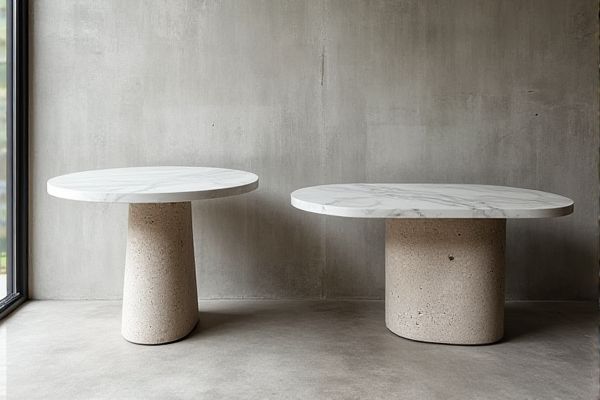
Concrete accent tables offer a modern, industrial look with durability and low maintenance, while marble accent tables provide a timeless, elegant aesthetic with unique veining but require more care to avoid stains and scratches. Discover which material best suits Your style and lifestyle by exploring the detailed comparison ahead.
Table of Comparison
| Feature | Concrete Accent Table | Marble Accent Table |
|---|---|---|
| Material | Cast concrete | Natural marble stone |
| Durability | Highly durable, resistant to scratches and dents | Durable but prone to chipping and staining |
| Weight | Heavy | Very heavy |
| Maintenance | Low maintenance; occasional sealing recommended | Requires regular sealing and careful cleaning |
| Appearance | Modern, industrial look with matte finish | Luxurious, polished surface with natural veining |
| Cost | Affordable to mid-range | Mid-range to high-end |
| Environmental Impact | Eco-friendly options available with recycled materials | Higher environmental cost due to quarrying |
| Heat Resistance | Good resistance to heat | Excellent heat resistance |
| Customization | Easy to mold into various shapes | Limited to natural stone cuts |
Introduction: Concrete vs Marble Accent Tables
Concrete accent tables offer a modern, industrial aesthetic with exceptional durability and low maintenance, ideal for both indoor and outdoor use. Marble accent tables showcase timeless elegance with natural veining and a luxurious finish but require more careful handling to prevent stains and scratches. Selecting between a concrete or marble accent table depends on your style preferences and how much upkeep you're willing to commit.
Material Composition and Durability
Concrete accent tables are composed of a mixture of cement, aggregates, and water, resulting in a dense, solid surface known for exceptional hardness and resistance to scratches and impacts. Marble accent tables consist of natural metamorphic stone rich in calcium carbonate, offering elegant veining and a polished finish but are more prone to scratches, stains, and etching from acidic substances. Durability-wise, concrete tables withstand outdoor elements and heavy use with minimal wear, while marble requires careful maintenance to preserve its aesthetic and avoid surface damage over time.
Aesthetic Appeal and Design Versatility
Concrete accent tables offer a modern, industrial aesthetic with a raw, textured surface that complements minimalist and urban interiors, while marble accent tables provide a timeless, luxurious appeal with their smooth, polished finish and natural veining that suits classic and elegant spaces. Concrete's neutral tones and modular shapes allow greater design versatility, enabling seamless integration into contemporary or eclectic decor, whereas marble tables, available in diverse colors and patterns, serve as striking focal points that enhance sophisticated settings. Both materials cater to distinct design preferences, with concrete excelling in durability and rugged charm, and marble delivering refined beauty and a sense of opulence.
Weight and Portability Comparison
Concrete accent tables are significantly heavier than marble accent tables due to the density and composition of concrete, making them less portable and more challenging to move around. Marble accent tables, while also heavy, tend to be slightly lighter and more manageable because of their thinner slabs and polished surfaces. Your choice between the two should consider the balance between durability and ease of relocation based on the weight and portability differences.
Maintenance and Cleaning Requirements
Concrete accent tables require regular sealing to prevent stains and moisture damage, and cleaning is best done with mild soap and water to avoid surface etching. Marble accent tables demand more delicate care due to their porous nature, needing frequent sealing and the use of pH-neutral cleaners to prevent staining and etching from acidic substances. Your choice between these materials should consider the time and effort you're willing to invest in maintenance to keep the table looking pristine.
Resistance to Stains and Scratches
Concrete accent tables offer exceptional resistance to scratches due to their robust and durable surface, making them ideal for high-traffic areas. Marble accent tables, while elegant, are more prone to staining and scratching because of their porous nature and softer composition. Protecting your marble table with sealants can help minimize damage, but concrete provides a more maintenance-free option for lasting durability.
Indoor vs Outdoor Suitability
Concrete accent tables offer superior durability and weather resistance, making them ideal for both indoor and outdoor settings where exposure to elements is a concern. Marble accent tables, while elegant and visually striking, are better suited for indoor use due to their susceptibility to staining and weather damage when placed outdoors. Your choice depends on whether you prioritize rugged outdoor functionality or refined indoor aesthetics.
Cost Analysis and Value for Money
Concrete accent tables generally offer a more budget-friendly option compared to marble accent tables, with prices often ranging from $200 to $600 versus marble's $500 to $2,000+. Concrete's durability and customizable finishes provide excellent value for money in modern, industrial-style interiors. Your choice depends on balancing initial cost with long-term investment, as marble offers timeless elegance but requires higher maintenance and upfront expense.
Environmental Impact and Sustainability
Concrete accent tables often have a higher carbon footprint due to cement production, which releases significant CO2 emissions, but they offer durability and can incorporate recycled materials, enhancing sustainability. Marble accent tables involve quarrying that disrupts natural landscapes and demands extensive energy, yet marble's longevity and potential for recycling contribute positively to its environmental profile. Your choice between concrete and marble should consider the balance between immediate environmental impact and the long-term sustainability of each material.
Choosing the Right Accent Table for Your Space
Concrete accent tables offer a modern, industrial look with exceptional durability and low maintenance, ideal for high-traffic areas or minimalist interiors. Marble accent tables bring timeless elegance and unique veining patterns, enhancing classic or luxurious decor while requiring more care to prevent stains and scratches. Selecting the right accent table depends on your lifestyle, design preferences, and the desired balance between functionality and aesthetic appeal.
 homyna.com
homyna.com